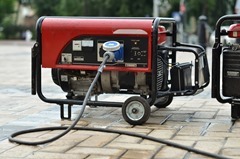If you have ever experienced the dreaded power outage at your own home, you know what a pain in the neck it can be. It’s in those moments you wish you had a generator to keep things running.
Generators are all around us, keeping things powered in the event of an electrical outage. They are also ready and waiting to keep things powered at places where electricity runs lifesaving machinery.
Many job sites where electricity is not available yet are running because of generators.
You might be wondering, how does a machine make electricity that doesn’t have access to electricity to run? How do generators work exactly?
Learn more about generators, their parts and how they function to make power.
How Do Generators Work Exactly
Think back to your elementary science days when you played with magnets and paperclips. As you moved those paper clips around with the force of the magnet, you were already experimenting with the science of electricity.
Generators, in simplified terms, use magnets to push electrons and create energy. Much the same way you moved the paperclips only in a supersized manner.
A generator holds a magnet which it moves near wiring. This causes electrons to move. It takes those electrons, traps them, then pushes them along to create an electrical current.
While this is highly simplified, it is the basic premise of a generator the size you might you use in your home all the way up to a huge one that might help to power a hospital or factory.
Parts Of a Generator
To understand how a generator works, again in basic terms, you need to know about the parts of a generator. Some of the most important parts include:
- The engine which runs on a fuel source. It is here where the generator gets the power to make electricity.
- The alternator is used to take the mechanical energy from the engine and convert it into electrical energy.
- The fuel system is the fuel used by the engine to create mechanical energy.
- The voltage regulator helps to control the electrical energy being converted and output it in the form of electricity.
- The frame or body of the unit holds all the parts of the generator. These can be small like a home generator. They can also be huge like the Hoover Dam.
Generators also need a way to keep the engine cool and handle emissions from the mechanical engine.
Types Of Generators
There are two main types of generators, thermal generators, and kinetic generators.
Thermal generators are the most commonly used. They run used a power source like natural gas, petroleum, and sometimes even coal.
Kinetic generators are typically much larger. Their power source comes from the movement of water or wind. The large windmills often seen spread across a field capturing wind are kinetic generators.
No matter your generator needs, we can help. Get more information on our generator services by visiting us at https://www.ablesales.com.au
Generators, Keeping Things Running
How do generators work? Take yourself back to science class and imagine playing with the magnet and paper clips. You are moving electrons, just like a generator does when it creates power.
Understanding the science of generators and how they create power is fascinating.
For more interesting technology-related information, visit our blog today.

